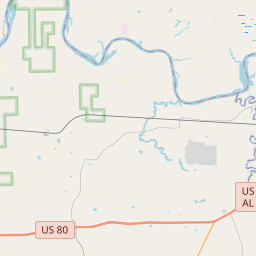Montgomery and Electricity / Hydroelectricity in the River Region
Historical marker location:
204 East Jefferson Street, Montgomery, Alabama
( Marker is at the intersection of East Jefferson Street and North Lawrence Street, on the right when traveling east on East Jefferson Street.)
Marker installed: 2006







© OpenStreetMap contributors
Loading...
Searching for other points of interest within 3 miles of this location.The Confederate submarine H.L. Hunley, which was the first submarine to sink an enemy ship in combat, was built in Mobile, Alabama in 1863.
About Montgomery County
Montgomery County Timeline
Montgomery County, Alabama has a rich and diverse history that stretches back centuries. The area's earliest inhabitants were Native American tribes, such as the Creek and Alibamu, who occupied the region for thousands of years. European exploration and settlement began in the 16th century, with French and Spanish explorers mapping the area. However, it was not until the early 19th century that Montgomery County began to take shape.
The county was officially established in 1816 and named after General Richard Montgomery, a Revolutionary War hero. The city of Montgomery, located in the heart of the county, quickly became its center of economic and political activity. The county's fertile soils made it ideal for agriculture, and cotton soon became the dominant crop. The heavy reliance on enslaved labor led to Montgomery County becoming a major hub of the domestic slave trade.
Montgomery County played a crucial role in the Civil Rights Movement of the 1950s and 1960s. The city of Montgomery was the site of several historically significant events, including the Montgomery Bus Boycott in 1955, sparked by Rosa Parks' refusal to give up her bus seat. This event marked a turning point in the fight against racial segregation and inspired similar movements across the country.
Today, Montgomery County continues to thrive as the capital of Alabama and a center for government, industry, and culture. The county is home to numerous historical landmarks, such as Old Alabama Town and the Civil Rights Memorial, which commemorate the area's rich history. With a diverse population and a growing economy, Montgomery County looks to the future while acknowledging its past and the important role it played in shaping the nation.
The county was officially established in 1816 and named after General Richard Montgomery, a Revolutionary War hero. The city of Montgomery, located in the heart of the county, quickly became its center of economic and political activity. The county's fertile soils made it ideal for agriculture, and cotton soon became the dominant crop. The heavy reliance on enslaved labor led to Montgomery County becoming a major hub of the domestic slave trade.
Montgomery County played a crucial role in the Civil Rights Movement of the 1950s and 1960s. The city of Montgomery was the site of several historically significant events, including the Montgomery Bus Boycott in 1955, sparked by Rosa Parks' refusal to give up her bus seat. This event marked a turning point in the fight against racial segregation and inspired similar movements across the country.
Today, Montgomery County continues to thrive as the capital of Alabama and a center for government, industry, and culture. The county is home to numerous historical landmarks, such as Old Alabama Town and the Civil Rights Memorial, which commemorate the area's rich history. With a diverse population and a growing economy, Montgomery County looks to the future while acknowledging its past and the important role it played in shaping the nation.
Montgomery County Timeline
This timeline provides a glimpse into the major events and milestones that have shaped the history of Montgomery County, Alabama.
- 1816: Montgomery County is established and named after Lemuel P. Montgomery, an early settler in the area.
- 1846: Montgomery becomes the state capital of Alabama.
- 1861-1865: Montgomery plays a significant role in the Civil War as the first capital of the Confederate States of America.
- 1870: The completion of the Montgomery and West Point Railroad connects Montgomery to the major port city of Mobile, boosting economic growth.
- 1955: The Montgomery Bus Boycott takes place after Rosa Parks refuses to give up her bus seat, becoming a pivotal moment in the Civil Rights Movement.
- 1965: Montgomery serves as a starting point for the historic Selma to Montgomery marches for voting rights.
- 2001: Hyundai opens a manufacturing plant in Montgomery County, bringing economic investment and job opportunities to the area.